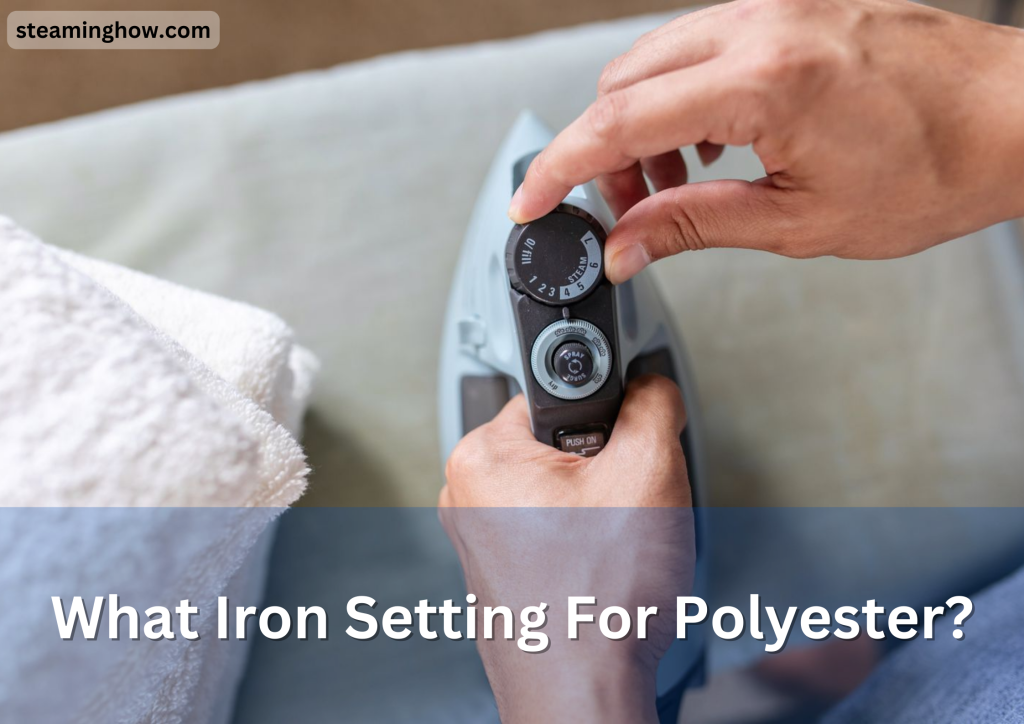Last Updated on July 18, 2023 by Erik Sullivan

Polyester fabric has revolutionized the world of fashion with its versatility and durability. This synthetic fiber has become a popular choice among clothing manufacturers and consumers alike, thanks to its ability to withstand wear and tear while retaining its vibrant colors and shape.
In this comprehensive guide, we will explore the optimal iron settings for polyester, share professional tips and techniques, and address common concerns related to ironing this synthetic fabric.
Whether you’re ironing polyester clothing, curtains, or dress shirts, this article will equip you with the knowledge and skills to achieve professional results while preserving the integrity of your garments.
Table of Contents
Can You Iron Polyester?
Ironing polyester is indeed possible, but it requires caution and adherence to appropriate temperature settings. While polyester boasts low heat retention and wrinkle resistance, improper ironing techniques can lead to irreversible damage.
Understanding the fabric’s characteristics and how to work with them is crucial for achieving the desired results. Let’s explore the best iron temperature setting for polyester.
What Iron Setting for Polyester?

To ensure successful ironing, it’s vital to set the correct temperature for polyester fabrics. Polyester is highly heat-sensitive, and excessive heat can cause melting or scorching. Most irons have temperature dials with various heat settings.
When ironing polyester, it is recommended to start with a low temperature setting, typically labeled as “synthetic” or around 110 degrees Celsius (230 degrees Fahrenheit). This moderate heat is usually sufficient to remove wrinkles without causing damage.
It’s important to note that different irons may use different scales, so referring to the ironing instructions on your clothing label can provide specific guidance. When in doubt, it’s better to err on the side of caution and start with a lower setting.
Factors Affecting the Iron Setting for Polyester
Fabric Weight and Thickness
When determining the ideal iron setting for polyester, consider the weight and thickness of the fabric. Thicker polyester fabrics generally require a lower heat setting, while lightweight polyester may tolerate slightly higher temperatures. Finding the right balance is key to prevent scorching or damaging the fabric.
Polyester Blends
Many garments feature polyester blends, combining this synthetic fiber with other materials like cotton or spandex. When ironing polyester blends, it is crucial to consider the most delicate component of the fabric and adjust the iron setting accordingly. Be cautious to avoid damaging the other fibers while ironing.
Exploring Different Ironing Techniques for Polyester
Low Heat Delicacy
Delicate polyester garments, such as blouses or dresses, require extra caution. Set your iron to the lowest heat setting (usually labeled as “synthetic” or “low”) and ensure the garment is slightly damp. Gently press the iron on the fabric without applying excessive pressure.
Moderate Heat Confidence
For structured polyester garments like jackets or pants, a moderate heat setting is suitable. Set the iron to a medium-low temperature, and use a pressing cloth to protect the fabric. Apply light pressure and move the iron in gentle, straight strokes to preserve the garment’s shape.
Cool Iron Refresh
When dealing with polyester blends or fabrics with embellishments, a cool iron setting is often recommended. This technique helps refresh the fabric and remove minor wrinkles without subjecting it to excessive heat. Use a pressing cloth to protect delicate details.
Steam Power
Steam is a valuable tool when ironing polyester. If your iron has a steam function, use it to your advantage. Hold the iron slightly above the fabric and release bursts of steam to relax the wrinkles. Be cautious not to touch the fabric directly with the iron to prevent damage.
Steps on Ironing Polyester Like a Professional

Ironing polyester like a professional involves following a series of steps to achieve the best results. Let’s explore these steps and learn how to transform wrinkled polyester into smooth, pristine garments.
Use a Pressing Cloth
Before ironing, place a clean pressing cloth, such as a thin cotton fabric, between the iron and the polyester garment. This acts as a protective barrier, preventing direct contact and reducing the risk of heat damage or shine marks.
Set the Iron’s Temperature to Low
Adjust the iron’s temperature to the recommended setting for synthetic fabrics or the lowest heat setting available. This ensures that the heat applied is gentle enough to avoid damaging the polyester fibers.
Test the Temperature First
Before ironing the entire garment, test the iron’s temperature on a small, inconspicuous area. This step helps ensure that the selected temperature is appropriate and won’t cause damage. If the fabric shows any adverse reactions, lower the temperature further.
Dampen the Fabric
Lightly spray the polyester fabric with water or use the steam burst feature on your iron. Moisture helps relax the fibers, making them more pliable and facilitating wrinkle removal. Be cautious not to saturate the fabric excessively, as this can cause water spots or prolong drying time.
Don’t Leave the Iron in One Spot
When ironing polyester, keep the iron moving in small, circular motions. Leaving the iron stationary for too long can result in heat damage or fabric distortion. Continuous movement ensures even heat distribution and prevents scorching.
Frequently Asked Questions
What happens if I use high heat on polyester?
Using high heat on polyester can cause the fabric to melt, warp, or burn. It is crucial to use the appropriate iron setting to prevent irreversible damage.
Can I iron polyester without using steam?
Yes, you can iron polyester without using steam. Adjust the iron to the recommended heat setting for polyester and follow the appropriate ironing technique for your garment.
Is it necessary to use a pressing cloth when ironing polyester?
While not always necessary, using a pressing cloth can provide an extra layer of protection, especially for delicate or textured polyester fabrics. It helps prevent direct heat contact and minimizes the risk of shine or imprints.
Can I use a garment steamer instead of an iron for polyester?
Yes, a garment steamer can be an excellent alternative to an iron for polyester. The steam helps relax the fabric and smooth out wrinkles without direct contact, reducing the risk of damage.
What if my polyester garment has a care label with specific ironing instructions?
Always follow the care instructions on the garment’s label. If the label specifies a particular temperature setting or advises against ironing, adhere to those recommendations to prevent damage to the polyester fabric.
What if my iron doesn’t have specific temperature settings?
If your iron doesn’t have adjustable temperature settings, it’s advisable to test a small, inconspicuous area of the polyester fabric first. Start with a lower heat setting and gradually increase if needed, always exercising caution to avoid damage.
Summary
In summary, selecting the correct iron setting for polyester garments is essential to prevent damage and ensure effective wrinkle removal. Polyester fabrics are sensitive to heat, and using a high-temperature setting can lead to melting or scorching. It’s recommended to set the iron to a low or medium heat setting, typically labeled for synthetic fabrics, and to check the care label on the polyester garment for specific instructions.
By embracing the delicate balance between heat and polyester, you can achieve wrinkle-free perfection and unlock the true potential of this versatile fabric. Ironing polyester is not only a practical necessity but also an art form that combines science and technique to maintain the durability and beauty of your garments.
Related Posts






[…] First of all, set the iron to the lowest heat setting. […]